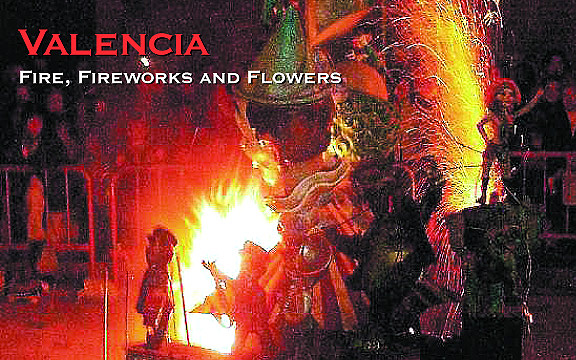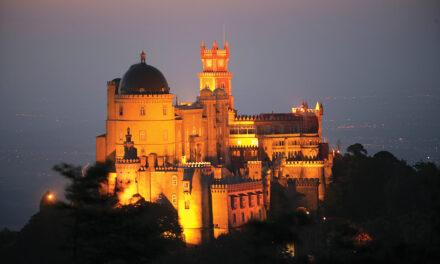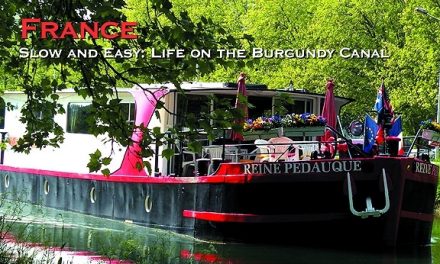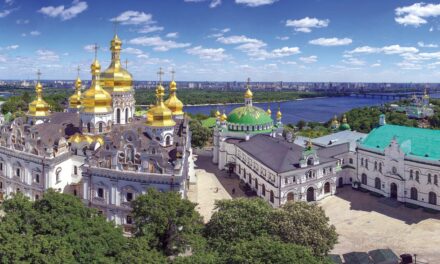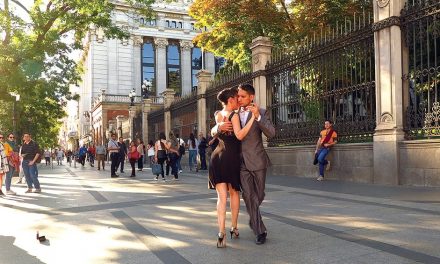Valencia
Fire, Fireworks and Flowers
Published in the Summer 2008 Issue of Canadian World Traveller
By Greg James
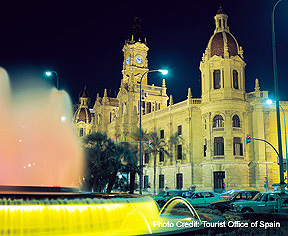 When one thinks of Spain, visions of Madrid, Barcelona or Sevilla immediately come to mind.But on a recent trip to Valencia during its annual Fallas Festival, I discovered that Spain’s third largest city is in every way just as fascinating and exciting as the rest of the country
When one thinks of Spain, visions of Madrid, Barcelona or Sevilla immediately come to mind.But on a recent trip to Valencia during its annual Fallas Festival, I discovered that Spain’s third largest city is in every way just as fascinating and exciting as the rest of the country
And what exactly is Fallas, you may ask. Think of a metropolitan city of 1,738,690, located halfway down Spain’s Mediterranean coast, whose residents and countless visitors celebrate the arrival of spring in mid-March with daily fireworks in the very heart of the city, parades of marching bands along closed streets and exploding firecrackers at every turn.
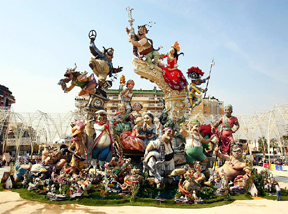 Add to all this, processions of thousands of women and children in elaborate traditional costumes bearing flowers for the Virgin, late night dining on scrumptious local specialities and lively open-air street parties that go on into the wee hours of the morning.
Add to all this, processions of thousands of women and children in elaborate traditional costumes bearing flowers for the Virgin, late night dining on scrumptious local specialities and lively open-air street parties that go on into the wee hours of the morning.
But most unique of all, is the astounding sight of fantastic temporary papier-mâché monuments, standing tall in almost every square, which are all fated to be consumed by fire on just one extraordinary night. This is Fallas in the exuberant city of Valencia!
Modern Metro Ride
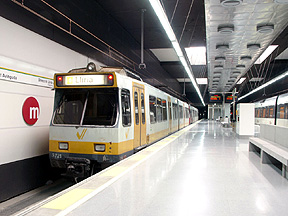 On the arrival of my Iberia Airlines flight at Valencia’s Airport, located about 8 km west of the city, I was pleasantly surprised to find that there was a metro station directly connected to the airport terminal.
On the arrival of my Iberia Airlines flight at Valencia’s Airport, located about 8 km west of the city, I was pleasantly surprised to find that there was a metro station directly connected to the airport terminal.
Valencia’s ultra-modern system consists of more than 134 km of track on five interconnecting lines that crisscross the city and even reach out to the suburbs.
A single ticket costs only 1.30 Euros, so for just over $2.00 Canadian, I was whisked right into the centre of the city in a matter of minutes!
A River Without Water
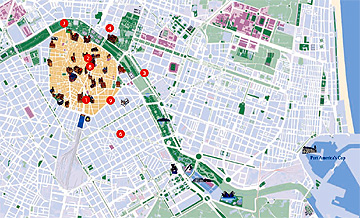 I came up from the Alameda metro station to find myself standing on the bank of a dry riverbed where the Turia River once ran on its way to the Mediterranean.
I came up from the Alameda metro station to find myself standing on the bank of a dry riverbed where the Turia River once ran on its way to the Mediterranean.
I later found out the reason for this. After a catastrophic flood in 1957 that devastated Valencia, the river was diverted southwards along a new course, skirting the city limits.
The remarkable thing is that the old riverbed is now a 5-km long sunken, meandering, lineal park that allows cyclists and pedestrians to traverse much of the city without the use of its roads. This verdant park is called the ‘Jardí del Túria‘ (the ‘Garden of the Turia’ in the Valencian language, which is quite distinct from Castilian Spanish and Catalan).
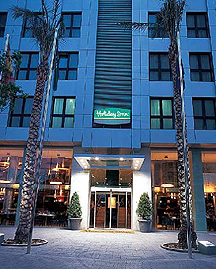 It boasts numerous ponds, paths, fountains, trees and flowerbeds, an athletics track, a Zen garden and a children’s adventure playground, featuring a huge fibreglass model of Gulliver tied to the ground with ‘ropes’.
It boasts numerous ponds, paths, fountains, trees and flowerbeds, an athletics track, a Zen garden and a children’s adventure playground, featuring a huge fibreglass model of Gulliver tied to the ground with ‘ropes’.
The many bridges that crossed the original river now carry vehicular traffic over the park.
As the weather in Valencia in mid-March was more like an early summer’s day in Canada, I decided to walk along the park’s pathways, which would take me to my hotel, Valencia’s 4-star Holiday Inn, located along the northern ‘bank’ of the park.
I could sense that both the young and old Valencians that I passed by had a real feeling of proud ownership of their wonderful city.
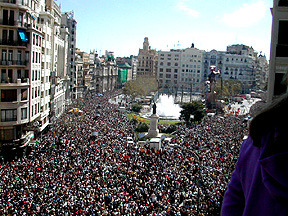
Daytime Fireworks
Before visiting Valencia, I had never heard about daytime fireworks displays. Yet here I was, along with thousands of other spectators, standing in the city’s historic City Hall Square at 2:00 p.m. on a warm sunny March day about to witness the most spectacle pyrotechnical display I have ever seen (or heard) in my entire life!
The Mascleta (daytime fireworks) is a thrilling part of the Fallas Festival. It takes place over an astounding 19 days, beginning on the first of March and ending on St. Joseph’s Day (March 19). Many major city streets are closed to traffic for several hours each day to accommodate the amassing of the huge crowds.
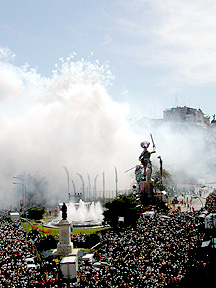 As I stand shoulder to shoulder with the tightly packed local and visiting spectators, the sense of expectation is tangible, the charged atmosphere being one of a huge street party. At the appointed hour, the fireworks, for which Valencia is justly famous, begin to explode.
As I stand shoulder to shoulder with the tightly packed local and visiting spectators, the sense of expectation is tangible, the charged atmosphere being one of a huge street party. At the appointed hour, the fireworks, for which Valencia is justly famous, begin to explode.
At first the bursts are relatively low, both in sound and height, but during the next six or seven minutes they become louder, higher and more frequent, sometimes sounding like thunderclaps or rapid machinegun fire and rising higher that the tall buildings surrounding the historic square.
The spectacular crescendo is aptly called the “terremoto” (earthquake), as hundreds of “masclets” explode simultaneously and fill the square with smoke to the applause of the animated crowd. This is a truly unique event and a not-to-be-missed part of the Fallas experience.
A Bird’s Eye View
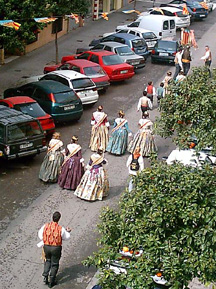
Lunch or supper at Valencia’s Centro Sagardi Restaurant is an unforgettable experience at any time of the year, but during Fallas there is an added bonus.
You see, the spacious two-storied restaurant is located on San Vincente Martir, which is one of the main streets used for the procession of the literally thousands and thousands of “Falleras” and “Falleros” as they wend their way to the Plaza de la Virgen.
We were fortunate to have a table on the second floor of the restaurant overlooking the street and could watch the proceedings through the floor-to-ceiling windows, while lunching on tasty local specialities like ham croquettes and cod omelettes, accompanied by bottles of excellent regional red and white wines.
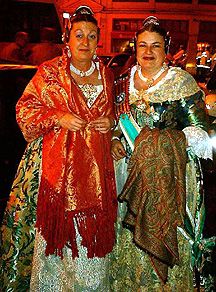
Spectacular Parade
The “Falleras” in the procession were local women and girls decked out in handmade ornate regional costumes. Each outfit seemed to have a unique design and colour combination. The women all wore beautiful jewellery and floor-length lace mantillas that partially covered their carefully coifed traditional hairstyles.
Each “Fallera” clutched a bouquet of flowers to be offered to “la Virgen de las Desamparados“, the patroness of Valencia, in the square of the same name. Whether young or old, beautiful or plain, thin or fat, each and every woman looked equally regal and proud.
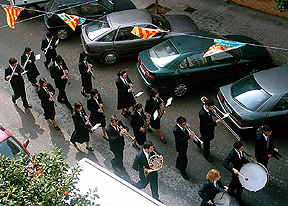
Many of the “Falleros”, the men and boys in the procession, played musical instruments as they marched along. In fact, I was told that Valencia boasts the highest number of musicians per capita in the entire world!
What I also found surprising was the participation in the long procession of very young children and even babies being pushed in strollers.
It seems that during their pregnancies, many of the young mothers had promised the Virgin to bring their babies to pay her homage in return for having successful deliveries.
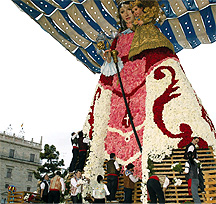 Grand Flower Offering
Grand Flower Offering
When the “Falleras” arrived at the Plaza de la Virgen, they offered up their bouquets to be added to the enormous wooden frame that formed the garment of the giant-sized representation of the Virgin holding the infant Christ.
Overcome with emotion, some of the women cried as they handed their bouquets to the agile young men who constantly clambered up and down the wooden framework to attach the flowers that would eventually form the colourful design of the Virgin’s garment. I found the genuine devotion of the “Falleras” so affecting, that I myself had to wipe away a tear or two.
Apparently, there are not enough flowers grown in Spain to fill the tremendous demand of ‘La Ofrenda‘ (the Offering), so at this time of year, many of the blooms are imported from as far away as the Netherlands.
Because of the size of the event, it is held on two days (March 17 and 18) beginning about noon and continuing late into the night, including the participation of the sleepy-eyed babies and tots!
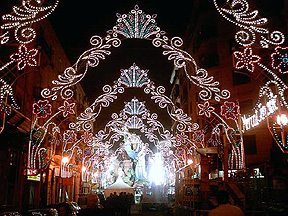 Lights and Monuments
Lights and Monuments
After a wonderful supper at the cozy family-run La Riua Restaurant, I had the chance to explore the streets and squares in the central district of Valencia. The streets were decorated with scores of illuminated arches, which were different in each neighbourhood.
The local Fallas committees are responsible for the street decorations in their own districts and the amazing temporary papier-mâché monuments gracing their local neighbourhood squares.
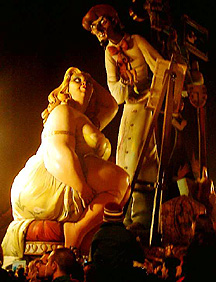
Apparently, there is fierce competition between the committees for the prizes for the best street decorations and monuments.
I actually had an opportunity to meet the president of one of the Fallas organizations, who took his job quite seriously, and the local neighbourhood reigning Fallas King and Queen. I must say, as I chatted with them, it felt like as if I were meeting with genuine royalty!
The monuments are usually several metres tall and often poke fun at public figures and institutions. But, the cost is no laughing matter, as it takes teams of skilled designers and artisans many months to design and build them.
It was hard for me to understand how so much effort and money could go into something that would be ultimately destroyed on purpose.
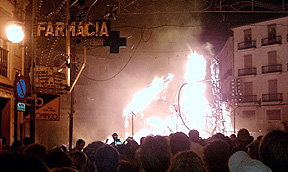
Ah! But on the night of the burning, “La Crema” (March 19), when all of these fabulous creations would be consumed by fire, I would experience something so magical that it is hard to put it into words.
You really have to be there in person to truly appreciate this extraordinary and truly unique annual ritual!
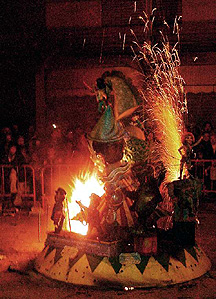 History of Las Fallas
History of Las Fallas
The origins of Fallas go back some time to the middle of the 18th century when it is said that, because of the longer days on the arrival of spring, local carpenters no longer needed the light from torches (or Fallas) to do their work.
In celebration of this annual event, they invited local residents to throw their unwanted furniture into the city squares where it was set on fire! Anyway, that’s as good a story as any other that I heard while in Valencia, and there are many!
The official explanation has more to do with supposed historic events that occurred during the religious celebration of St. Joseph’s Day (March 19). Others claim that Fallas is the remnants of some long-forgotten pagan festival.
Whatever its real origins, Fallas is now a world-class annual festival drawing thousands of visitors from around the globe.
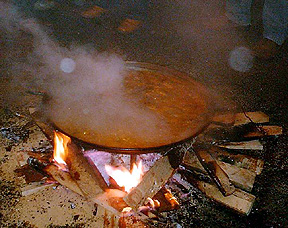
Valencian Paella
How could I visit Valencia without indulging in its world-famous dish? I had a chance to do just that at lunch at the beautiful La Matandeta Restaurant located some 4 km outside of the city.
In the family-run restaurant’s pastoral setting, surrounded by rice fields, I thoroughly enjoyed an authentic Valencian paella prepared with heavenly saffron-flavoured short-grain Spanish rice, duck, chicken and rabbit.
Generous portions were served to us by the attentive waiters from a metre-wide pan brought directly from wood-burning oven to table. What a treat that was! The thought of the aroma alone makes me salivate. The whole experience was definitely worth this little out-of-town excursion.
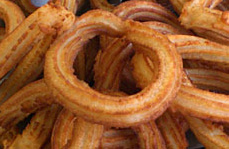 Valencia’s Other Treats
Valencia’s Other Treats
Anyone with a sweet tooth will be in seventh Heaven in Valencia, especially during Fallas. It seems there is a café or temporary Fallas food kiosk around every corner offering the kind of tempting snacks that I defy anyone to resist.
Before leaving the city, every visitor must try a cup of Valencia’s thick and delicious hot chocolate. It’s perfect for dunking the tasty sweet “buñuelos” and “churros” (small donut-like balls and twisted crunchy sticks of dough, respectively) that are sinfully deep-fried right before your eyes then dusted with white sugar.

Another Valencia speciality is a refreshing cool frothy drink called “horchata“. Made with crushed tiger-nuts, water and sugar, this delicious concoction is usually served with a kind of cigar-shaped sweet bun called a “farton“! No one ever orders just one.
While in Valencia, you can kiss your diet goodbye!
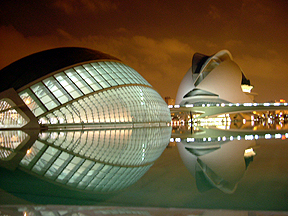
Out and About
Because my visit was primarily to take part in the Fallas Festival, there was little time left to explore Valencia’s other famous attractions.
However, I did manage a quick visit to the absolutely astounding City of Arts and Sciences. The ultramodern revolutionary buildings designed by local world-renowned architect Santiago Calatrava seem to float in the surrounding reflecting pools of water and some of them seem to defy gravity!
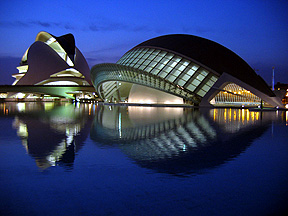
The five extraordinary pavilions (both inside and out) are worthy of being part of any World Expo.
The stunning structures of the “Ciudad de las Artes y las Ciencias” were just a pleasant 15-minurte walk from my hotel, along the previously mentioned Jardí del Túria urban parkway.
Try to visit them by day for the fascinating exhibits then return at night to see them illuminated. What a treat for the eyes!
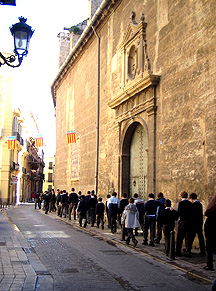 Historic Valencia
Historic Valencia
Having explored modern Valencia, I still had a few hours for a fascinating walk through the narrow streets and interesting squares of the well-preserved historic sector of the city.
Valencia was founded by the Romans in 138 BC on the site of a former Iberian town due to its strategic trading and defense position on Spain’s Mediterranean coastline.
The original Latin name of the city was Valentia, meaning “Strength and Vigor”. It was named after Roman Emperor Valens, who decreed its establishment.
The city was later conquered by the Moors then captured for the Christians by the famous El Cid in 1096. It was retaken by the Moors but recaptured by Jaime I, the Conqueror, in 1238 and became part of the Kingdom of Aragon.
Today, the city is the capital of the Autonomous Community of Valencia and the Spanish province bearing the same name.
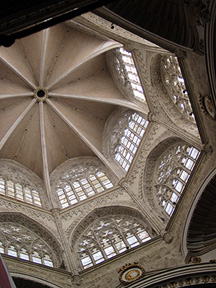 I started my walk by passing through the Torres de Serranos. Erected in 1238, it was both a triumphal arch and a defensive gateway in the now dismantled city walls.
I started my walk by passing through the Torres de Serranos. Erected in 1238, it was both a triumphal arch and a defensive gateway in the now dismantled city walls.
Because of the crowds of Fallas visitors, I only had a precursory visit of the many historic buildings located within the impressive gates, the first stop being at the 17th-century Basilica de la Virgen de los Desamparados, the site of the Fallas flower offering.
Next came Valencia’s historic Cathedral, originally built in 1262 but added to over the centuries and said to house the genuine Holy Grail, an agate cup used by Jesus during the Last Supper.
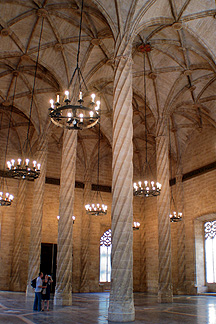
My final stop was to make a short visit to La Lonja, located on Plaza del Mercado.
It was built between 1482 and 1498 as a commodities trading exchange hall. This late Gothic-style secular building reflected the peak of commercial prosperity that Valencia attained during the fifteenth century. The building was designated a World Heritage Site by UNESCO in 1996 and is one of Valencia’s most visited tourist sites.
Both the alabaster windows in the dome of the cathedral and the twirling soaring columns of La Lonja’s “Hall of Columns” are worth a look.
I swore on my short visit to return to Valencia to do justice to the city’s many, many historic treasures!
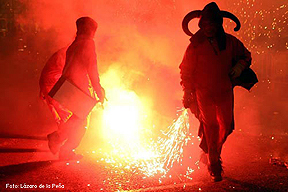
Fallas Finale
On the evening of my last day in Valencia and the final day of Fallas, I attended the most extraordinary night parade I have ever witnessed.
Dragons and all sorts of unearthly creatures shooting fireworks from their mouths and other orifices, dancing girls carrying pots of real fire, stilt-walking giants brandishing sticks that shot fireworks… this was the “Cabalgata del Foc” or Fire Parade witnessed by thousands along the route.
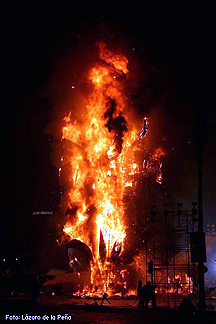 Sadly, this was the last official event of Fallas, save one, and it’s a big one!
Sadly, this was the last official event of Fallas, save one, and it’s a big one!
The burning of the mammoth monument in City Hall Square, the dramatic climax of “La Crema“, would begin at 1 a.m. Huge crowds from all over the city gathered there for the grand finale and when it came it didn’t disappoint.
As the huge flames shot up into the night sky, fireworks exploded all around them. Needless to say, Valencia’s finest members of its fire brigade were on hand in the event of any mishaps.
Even though I was quite a distance away from the now doomed monument, I could feel the warmth from the skyward-shooting flames on my upturned face. As the monument crumbled into a pile of ashes to the thundering applause of the gathered thousands of spectators, I swore that I would return to visit invigorating, exciting Valencia.
Viva Fallas! Viva Valencia!
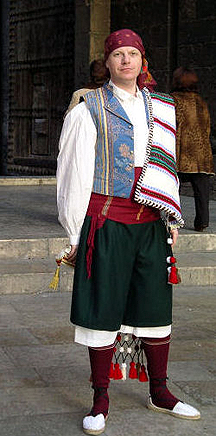
For More Info:
Tourist Office of Spain
2 Bloor Street W, Suite 3402
Toronto, Ontario, M4W 3E2
Tel.: 416-961-3131
Email: toronto@tourspain.es
www.spain.info/ca
Region of Valencia Tourism
www.comunitatvalenciana.com
Fallas de Valencia
www.valenciavalencia.com/culture-guide/fallas/fallas.htm
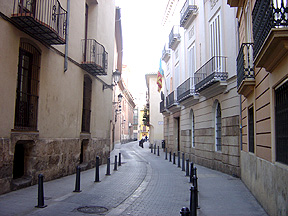
Getting There:
Iberia Airlines
Tel.: 1-800-772-4642
Website: www.iberia.com
Where to Stay:
Holiday Inn Valencia
Website: www.ichotelsgroup.com/h/d/hi/925/en/hotel/VLCPA/welcome

